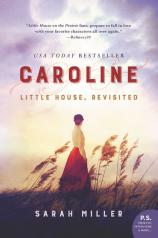Caroline: Little House, Revisited
Review
Caroline: Little House, Revisited
“It was a kind of sorcery: What [Mary and Laura] believed of her, they made real, and in so doing fed back to her. Every day it happened...their faces cried out for a refuge, steady and serene, and that is what she had become, lifted from her own doubts by sheer force of their need.”
In 1932, Laura Ingalls Wilder published LITTLE HOUSE IN THE BIG WOODS chronicling her life growing up in frontier America, the first of many books to follow. Since that time, children’s imaginations have been captured by the Ingalls family adventures that have grown more and more beloved with each passing generation. When the series was adapted for television in 1974, Wilder’s stories gained an even broader fan base. To this day, the Little House books have sold many millions of copies andremain a celebrated iconic body of literature cherished by young and old who have grown up with them as a reading rite of passage.
Though the stories were told from Laura’s perspective as a child, the main hero of the books was unquestionably Charles Ingalls --- known as “Pa” to Laura and readers alike. Whether he was playing the fiddle, befriending Indians, protecting and providing for his homestead, or encouraging Laura’s tomboy-ish antics, Pa Ingalls inhabited the pages as a larger-than-life father in every way.
"Those who grew up with and loved the Little House series will enjoy a richer, more colorful trip down memory lane. And newcomers to the tales of the Ingalls family will find a rustic elegance in the vivid storytelling that will transport them back in time."
Now, with the Little House Heritage Trust’s blessing, Sarah Miller has mastered a difficult feat in CAROLINE: Little House, Revisited --- she manages to retell the story of Little House on the Prairie (book two) from Caroline Ingalls’ point of view while staying true to Wilder’s original works. With a deft hand, Miller gives Ma Ingalls a voice and, in so doing, weaves a more intricate portrait of the Ingalls family’s life on the frontier. As the author crafted the story, she leaned heavily on the source material but writes in her Author’s Note, “I have knowingly departed from Wilder’s version of events...where the historical record stands in contradiction to her stories.” So, true enthusiasts of Little House on the Prairie will find a few significant changes to freshen the reading experience.
In addition to the nostalgic return to these stories, through Caroline’s eyes readers will glimpse what life was like for a woman living back in the 1800s. As a wife and mother caring for her household, full days were dedicated to laundry or mending. Every scrap of every resource was put to good use. Preparing for a long journey across the country meant sewing the wagon cover and treating it with linseed oil to waterproof it.
With each task that Caroline performs, Miller sketches a view into history. While I sometimes felt that the overly depicted actions were at the expense of character development, overall I appreciated the story that they told. As I read, CAROLINE became a stark reminder that we stand on the shoulders of those Americans who were brave enough to travel towards the unknown and unmapped, stake a homestead claim, and settle in parts of the country where resources were few and hardships could be devastating.
Yet, for all the differences in lifestyle that decades of time have brought us as a society, there’s still so much about Caroline’s journey to which we can relate. Motivated by a love for her husband and care for her children, Caroline’s internal struggles and triumphs speak to a larger face of humanity that is just as true today as it was back then.
Perhaps the greatest enhancement Miller brings to this story is a more complex look at Charles and Caroline Ingalls’ marriage. Throughout the book, Caroline takes the role of dutiful wife, deferring to Charles’ decisions as the head of the household, but it’s clear that Ma and Pa are a team. They depend on each other, support each other, and find time for romance through the ups and downs of whatever comes their way. And it is equally apparent that without Caroline as his better half, Charles would not be the Pa Ingalls who lived in Wilder’s memories as she set pen to page.
CAROLINE is, at times, overwritten. And the pacing can seem a bit uneven because of the nature of biographical storytelling. Still, the book is a delight from start to finish. Those who grew up with and loved the Little House series will enjoy a richer, more colorful trip down memory lane. And newcomers to the tales of the Ingalls family will find a rustic elegance in the vivid storytelling that will transport them back in time.
Reviewed by Amy Haddock on September 22, 2017
Caroline: Little House, Revisited
- Publication Date: June 12, 2018
- Genres: Fiction, Historical Fiction, Women's Fiction
- Paperback: 400 pages
- Publisher: William Morrow Paperbacks
- ISBN-10: 006268535X
- ISBN-13: 9780062685353



